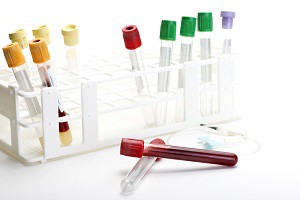Written by Greg Arnold, DC, CSCS. Of the 97 study participants with beta-thalassemia, those who supplemented with 720 mg of silymarin per day for 9 months had a 43.6 % decrease in iron blood levels and an average 22.5% decrease in liver enzymes compared to control.
 Beta thalassemia is a blood disorder that reduces the body’s production of hemoglobin, leading to a lack of oxygen in many parts of the body. Those with beta thalassemia also have a shortage of red blood cells which can cause pale skin, weakness, fatigue, and more serious complications (1). Those with beta thalassemia major usually require frequent blood transfusions for their anemia. However, this can cause a dangerous buildup of iron in the body that can generate harmful free radicals and cause tissue and multi-organ damage (2).
Beta thalassemia is a blood disorder that reduces the body’s production of hemoglobin, leading to a lack of oxygen in many parts of the body. Those with beta thalassemia also have a shortage of red blood cells which can cause pale skin, weakness, fatigue, and more serious complications (1). Those with beta thalassemia major usually require frequent blood transfusions for their anemia. However, this can cause a dangerous buildup of iron in the body that can generate harmful free radicals and cause tissue and multi-organ damage (2).
Treatment for thalassemia major is done with an injection of the medication desferrioxamine (2) but compliance is an issue (3), leading to the buildup of iron. As a result, finding adjunctive treatments for beta thalassemia is needed. Fortunately, research has started to suggest that silymarin, a potent antioxidant (4) known to help maintain both healthy levels of iron in the body (5) and liver health (6), may benefit those with thalassemia.
A 2013 study (7) involved 97 subjects (45 men, 52 women) between the ages of 16 and 26 with beta-thalassemia. They took either a medication for thalassemia (desferrioxamine) along with 720 milligrams per day of silymarin (taken as 140 mg 3 times daily = 49 subjects) or desferrioxamine by itself (48 subjects) for 9 months. Blood samples were taken before and after the study to assess for liver health. The silymarin dose was used based on previous research (8, 9).
After 9 months, researchers noted the following:
| Desferrioxamine + Silymarin | Desferrioxamine + placebo | p-value | |
|---|---|---|---|
| Iron blood levels (micrograms/deciliter) | 29.3% decrease (164 to 116) | 14.3% increase (149.1 to 170.5) | < 0.05 |
| sTfR (nanomolar) | 4.1% increase (106.7 to 111.1) | 20.4% decrease (136.6 to 108.8) | < 0.05 |
| Hepicidin (nanomgrams/mL) | 16.7% decrease (94.9 to 78.8) | 12.6% decrease (112.5 to 98.4) | < 0.05 |
In addition, silymarin preserved liver health by maintaining healthier levels of liver enzymes:
| Desferrioxamine + Silymarin | Desferrioxamine + placebo | p-value | |
|---|---|---|---|
| AST (International Units/Liter) | 23.4% decrease (33.8 to 25.9) | 28% increase (27.1 to 34.7) | < 0.05 |
| ALT (IU/L) | 10.9% decrease (30.3 to 27.0) | 32.1% increase (27.4 to 36.2) | < 0.05 |
| ALP (IU/L) | 40.6% decrease (251.7 to 149.7) | 8.5% decrease (298.1 to 273.0) | < 0.05 |
For the researchers, “the combined therapy of oral silymarin with subcutaneous infusions of desferrioxamine, in the manner used in this study, had greater efficacy than daily infusions of desferrioxamine alone in controlling the body iron load in transfusion-dependent patients”. They admit that “further work is required, however, to understand the effectiveness of silymarin alone in reducing body iron burden.”
Source: Moayedi, Behjat, Marjan Gharagozloo, Nafiseh Esmaeil, Mohammad R. Maracy, Hamid Hoorfar, and Mohsen Jalaeikar. “A randomized double‐blind, placebo‐controlled study of therapeutic effects of silymarin in β‐thalassemia major patients receiving desferrioxamine.” European journal of haematology 90, no. 3 (2013): 202-209.
© 2012 John Wiley & Sons A/S
Posted September 1, 2016.
Greg Arnold is a Chiropractic Physician practicing in Hauppauge, NY. You can contact Dr. Arnold directly by emailing him at PitchingDoc@msn.com or visiting his web site at www.PitchingDoc.com.
References:
- “Beta thalassemia major” posted on the U.S. Library of Medicine website
- Rund D, Rachmilewitz E. Beta-thalassemia. N Engl J Med 2005;353:1135–46
- Jomova K, Valko M. Importance of iron chelation in free radical-induced oxidative stress and human disease. Curr Pharm Des 2011;17:3460–73
- Gazak R, Walterova D, Kren V. Silybin and silymarin – new and emerging applications in medicine. Curr Med Chem 2007;14:315–38
- Borsari M, Gabbi C, Ghelfi F, Grandi R, Saladini M, Severi S, Borella F. Silybin, a new iron chelating agent. J Inorg Biochem 2001;85:123–9
- Hutchinson C, Bomford A, Geissler CA. The iron-chelating potential of silybin in patients with hereditary haemochromatosis. Eur J Clin Nutr 2010;64:1239–41
- Maoyedi B. A randomized double-blind, placebo-controlled study of therapeutic effects of silymarin in β-thalassemia major patients receiving desferrioxamine. Eur J Haematol. 2013 Mar;90(3):202-9. doi: 10.1111/ejh.12061. Epub 2013 Jan 20
- Saller R, Meier R, Brignoli R. The use of silymarin in the treatment of liver diseases. Drugs 2001;61:2035–63
- Gharagozloo M, Moayedi B, Zakerinia M, Hamidi M, Karimi M, Maracy M, Amirghofran Z. Combined therapy of silymarin and desferrioxamine in patients with beta-thalassemia major: a randomized double-blind clinical trial. Fundam Clin Pharmacol 2009;23:359–65
